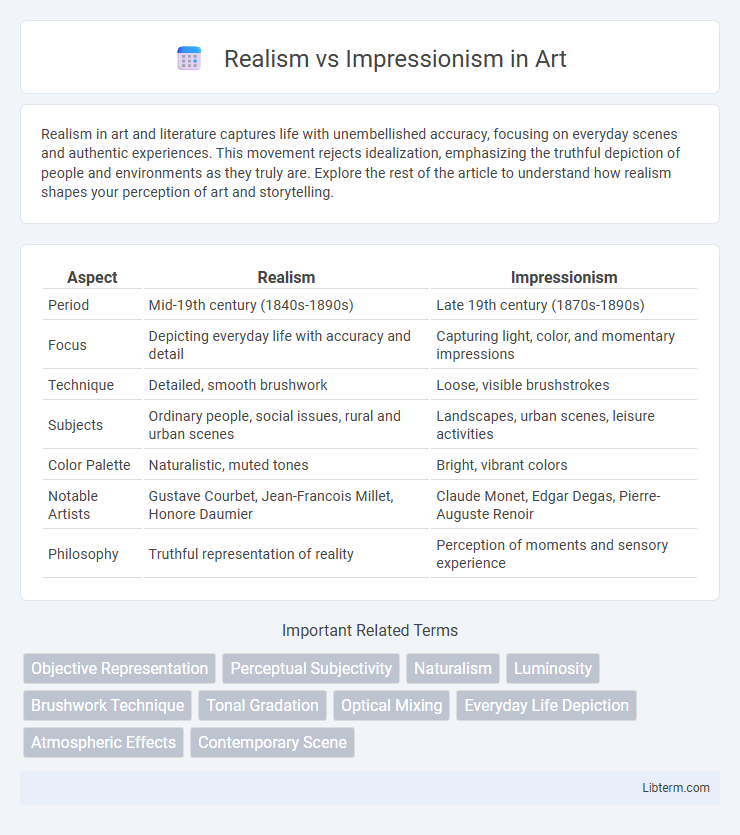Realism in art and literature captures life with unembellished accuracy, focusing on everyday scenes and authentic experiences. This movement rejects idealization, emphasizing the truthful depiction of people and environments as they truly are. Explore the rest of the article to understand how realism shapes your perception of art and storytelling.
Table of Comparison
| Aspect | Realism | Impressionism |
|---|---|---|
| Period | Mid-19th century (1840s-1890s) | Late 19th century (1870s-1890s) |
| Focus | Depicting everyday life with accuracy and detail | Capturing light, color, and momentary impressions |
| Technique | Detailed, smooth brushwork | Loose, visible brushstrokes |
| Subjects | Ordinary people, social issues, rural and urban scenes | Landscapes, urban scenes, leisure activities |
| Color Palette | Naturalistic, muted tones | Bright, vibrant colors |
| Notable Artists | Gustave Courbet, Jean-Francois Millet, Honore Daumier | Claude Monet, Edgar Degas, Pierre-Auguste Renoir |
| Philosophy | Truthful representation of reality | Perception of moments and sensory experience |
Introduction to Realism and Impressionism
Realism emerged in the mid-19th century as a reaction against Romanticism, emphasizing accurate, detailed depictions of everyday life and ordinary people without idealization. Impressionism developed in the late 19th century, characterized by loose brushwork, light colors, and a focus on capturing fleeting effects of light and atmosphere in outdoor settings. Both movements shifted the art world's focus toward modern life but differed fundamentally in technique and thematic approach.
Historical Context and Origins
Realism emerged in the mid-19th century as a reaction to Romanticism, emphasizing accurate, unembellished depictions of everyday life and social issues during the Industrial Revolution. Impressionism originated in the 1870s in France, influenced by advancements in optical science and photography, highlighting light, color, and momentary visual impressions over precise detail. Both movements reflect societal shifts in 19th-century Europe, with Realism rooted in socio-political critique and Impressionism exploring modernity and sensory experience.
Key Philosophies and Ideals
Realism centers on depicting everyday life with precise detail and an objective approach, emphasizing social realities and ordinary subjects without idealization. Impressionism prioritizes capturing fleeting moments and sensory impressions through loose brushwork and vibrant light effects, highlighting perception over exact representation. These divergent philosophies illustrate Realism's commitment to truth and social commentary versus Impressionism's focus on personal experience and visual spontaneity.
Notable Artists and Influencers
Gustave Courbet and Jean-Francois Millet stand as prominent figures in Realism, emphasizing truthful, unembellished depictions of everyday life and social issues. Impressionism, influenced by artists like Claude Monet and Pierre-Auguste Renoir, revolutionized art with vibrant colors and light effects, capturing fleeting moments and sensory impressions. Edouard Manet bridged these movements, integrating Realist subjects with Impressionist techniques, profoundly shaping modern art's evolution.
Artistic Techniques and Styles
Realism emphasizes detailed, accurate depictions of everyday life, using precise brushwork and naturalistic colors to portray subjects with clarity and fidelity. Impressionism employs loose, quick brushstrokes and a vibrant color palette, capturing the fleeting effects of light and atmosphere to evoke sensory impressions rather than detailed representations. The contrasting techniques highlight Realism's focus on exactitude and social narrative versus Impressionism's exploration of visual perception and momentary ambiance.
Differences in Subject Matter
Realism focuses on depicting everyday life and ordinary people with precise detail, emphasizing social issues and the accuracy of the physical world. Impressionism, by contrast, captures fleeting moments, light effects, and vibrant colors often portraying landscapes, urban scenes, and leisure activities with quick, loose brushstrokes. The subject matter in Realism tends to be serious and grounded, whereas Impressionism embraces ephemeral, sensory experiences and atmospheric impressions.
Visual Characteristics and Color Usage
Realism emphasizes detailed, true-to-life depictions with sharp lines and natural lighting, capturing everyday scenes and textures meticulously. Impressionism employs loose brushwork and vibrant, often pastel hues to convey light effects and movement, prioritizing atmosphere over precise detail. Color usage in Impressionism highlights contrasts and transient moments, while Realism favors muted, earthy tones to reflect true visual experience.
Impact on the Art World
Realism challenged the dominant Romanticism of the 19th century by emphasizing everyday scenes and ordinary people, profoundly shifting artistic focus towards social realities and truthful representation. Impressionism revolutionized the art world with its innovative use of light, color, and brushstrokes, breaking from traditional techniques to capture fleeting moments and atmospheric effects. Both movements collectively paved the way for modern art by encouraging experimentation and expanding the boundaries of artistic expression.
Legacy and Influence Today
Realism's legacy endures in its commitment to portraying everyday life with unembellished accuracy, influencing contemporary documentary photography and social commentary art. Impressionism revolutionized visual perception by emphasizing light and color, laying the groundwork for modern abstract and expressionist movements. Both movements continue to shape artistic perspectives, inspiring a diverse range of creative explorations in visual culture today.
Choosing Between Realism and Impressionism
Realism emphasizes detailed, true-to-life representations, capturing everyday scenes with precise accuracy, making it ideal for those seeking to depict objective reality and social issues. Impressionism prioritizes light, color, and momentary impressions, focusing on the sensory experience and fluid brushwork, which appeals to those valuing emotional expression and atmospheric mood. Selecting between Realism and Impressionism depends on whether the goal is faithful representation or evocative, transient effects in visual art.
Realism Infographic

 libterm.com
libterm.com